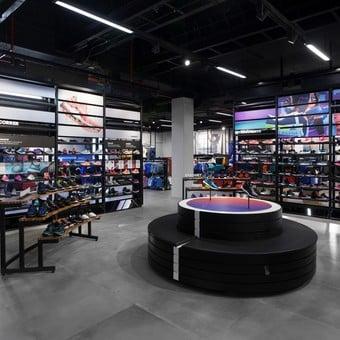Two colossi of sports fashion land in Argentina
After the normalization of imports, two colossi of sports clothing, the American Under Armor and the Japanese Asics, they plan to increase their presence in the country to compete with Adidas and Nike, the leaders.There are other global and premium profile brands that have similar plans, such as Brooks, Saucony, Hi-Tec, Sketchers, Head and Marmot, among others, who gain participation with local partners, in an increasingly sophisticated and diversified market."The business has potential and there is much to do.The greatest competition does not concern us because there is a place for everyone, ”said Raúl Fagale, Marketing Manager of the German Puma.
Under Armor's landing is the greatest impact.Since 2014 it is the second best -selling sports brand in the United States, after Nike, moving no less than Adidas.Its products with the logo of a double inverted and superimposed horseshoe, were distributed in the country by the Vieytes group, an agreement that expired in 2016.As it transpired, the company will begin next year to extend a network of own premises in Argentina, as already done in Chile and Brazil, where they sponsored Colo Colo and San Pablo."There is already talk of doing the same with River or Boca," said the economy Sebastián Forrester, Brand Manager of the Vieytes group.
Created just 20 years ago, in 1996, by Kevin Plank, a former rugby player from Maryland University, Under Armor did not stop growing inside and outside the USA.UU., in parallel with the sportswear business and its jump to casual use.Thus new categories emerged: fitness, running, sky, snowboarding, mountaineering, cycling and training, among many others.Which led to the demand for more traditional items (sneakers, shirts, divers) and also more specific ones, such as shoes, shorts, muscular, shirts, gloves, bags and backpacks."Footwear is the main thing, it is what it defines," interpreted Guillermo Gotelli, president and CEO of GGM, owner of the Italian brand license Signia.
Until last December, GGM had the exploitation rights of the Asics brand, which was not renewed."They made the decision to come on their own, directly," says Gotelli, and adds that it was his company "who launched the brand in the country, which settled very well and has a good demand".There were still no details about investment amounts or dates, but the businessman believes that the arrival of other brands to the local market generates uncertainty: “There is an oversupply due to import reopening.And on the other hand, the demand went down, it is a more recessive market, ”he said.

The Asics brand ("Anima Sana in Corpore Sano") is very recognized in sports environments.And like Under Armor, today channels sales through large commercial chains, such as Dexter, Falabella, only sports and netshoes, among others.The opening of offices in the country, coincide in the sector, will promote competition, especially in the high -end segment, where Adidas and Nike lead."These are the references and it is difficult for them to lose leadership," says Forrester.
The truth is that the market is very convulsed.Grupo Vieytes lost the rights of Under Armor, but has other strong brands, such as the American Brooks and Marmot, the Austrian Head, and the English Hi-tec.Forrester says he is in negotiations to bring "another 5 sports brands", but did not specify which."The market diversified and new niches appear," explained the executive.
Puma, by case, focuses on the female audience."The woman trains the same or more than the man.And we point to Sport Style, a category that aims to bring sport to everyday life.There is much to do, competition with new brands does not worry us.The question is to have a good product and arm yourself well, ”says Fagale.
Matías Blanco, director of the Blanco Group, who plays with Diadora and Athix (his own brand), argues that the opening of imports is something relative “if the rules are equal to all”.On the other hand, he clarifies that Under Armor's landing and Asics does not directly affect his business.“They are very large international players, who compete with Adidas and Nike and point to the target ABC1, only.Diadora is a step below, along with a row, puma and topper, ”added the executive.
In general, companies and manufacturers agree that the arrival of new players will impact high consumption segments, where the price of a couple of international brand shoes can quote above $ 3.000."When imports were released, the supply grew but demand fell," they highlight.
The use of sports clothing, today, transcends its borders and expands between informal fashion brands.Thus, it is not surprising that Ona Sáez has its own brand for sport (OSX) and also the Saucony license.“We try not to collide with the big ones or compete in the mass markets.Our points to the world of high boutique, ”says Santiago Sáez, creative director of the company, whose focus is casual clothes.
Sáez argues that the Argentine market is quickly being segmented, with many specific niches and great innovations."If the rules are couples for all, the new brands are welcome," he says.
Topics that appear in this note
Comments
Commenting Clarín's notes is exclusive to subscribers.
Subscribe to comment
I already have a subscription
Clarín
To comment you must activate your account by clicking on the e-mail we send you to the box, did you not find the e-mail?Click here and we send it to you again.
Ya la activeCancelarClarín
To comment on our notes please complete the following data.
